
- Category:
Home Energy Savings -
Last updated:
July 6, 2021
Which Energy Saving Tips Lower Your Energy Bill?
We all want to lower our energy bill. But we’re also bombarded every day with claims that making this or that particular change is the way to save the most money. It can be confusing to say the least. It also can be costly, because if you need to spend a little money to make an energy cost-cutting move, you certainly want to be sure the savings is worth it after the work is done.

Constellation wants to help you make the most informed energy decisions you can. “Your home relies on different systems throughout the year to keep your family comfortable, so it’s important to take a fresh look at your home’s energy usage each season,” says Brian Recor, Energy Expert at Constellation Home/BGE HOME. “Since over half of the typical home’s energy usage comes from heating and air conditioning, that’s always a good place to start. Next, technology is always changing and new tools are available that can help homeowners manage their energy usage throughout the day.”
To help you decide where to start analyzing your home’s energy needs and figure out the best places to spend your hard-earned cash, we took some of the most common energy saving tips circulating online and elsewhere and gathered the facts.
Energy saving tips that actually lower your energy bill:
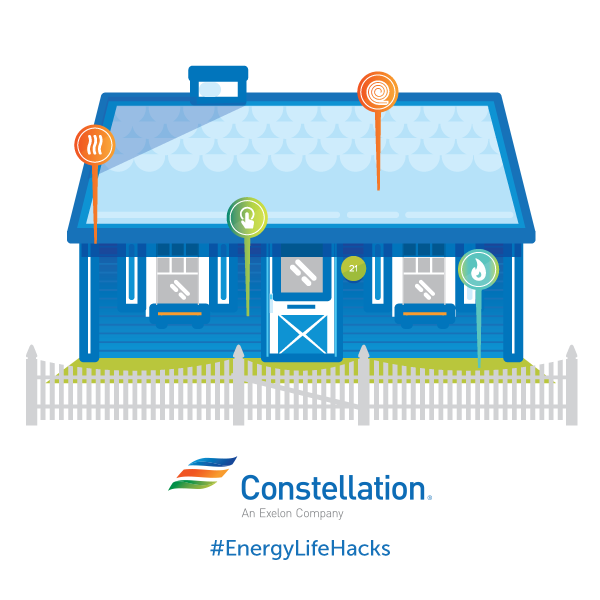
Improving your wall and attic insulation
 The Department of Energy (DOE) estimates that a properly insulated attic can shave 10 to 50 percent off your heating bill. And in warmer seasons that same insulation helps stabilize the indoor temperatures to keep your cooling needs lower. It’s the proverbial win-win.
The Department of Energy (DOE) estimates that a properly insulated attic can shave 10 to 50 percent off your heating bill. And in warmer seasons that same insulation helps stabilize the indoor temperatures to keep your cooling needs lower. It’s the proverbial win-win.
Here are some tips to consider when analyzing your insulation, according to the DOE:
- Make sure to use higher R-value insulation, such as spray foam, on exterior walls and for cathedral ceilings to get more insulation with less thickness. (R-value is the capacity of an insulating material to resist heat flow. The higher the R-value, the greater the insulating power.)
- Be sure your attic has air barriers such as wind baffles along its entire eave to ensure proper airflow from the soffit to the attic. Ventilation helps control moisture, which in turn helps reduce summer cooling bills.
- Don’t forget the attic trap door or access door when insulating. Ignoring that space can create a gaping hole.
#EnergyLifeHacks
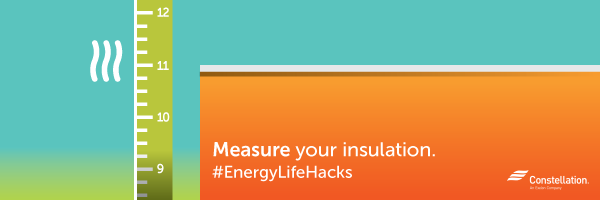
Not sure if your attic has enough insulation? Get out your measuring tape. If it is less than R-30 (that’s 11 inches of fiberglass or rock wool, or 8 inches of cellulose) you could probably get better results by adding more.
Want to get an estimate of how much insulation your home needs? Just type in your zip code here and get an estimate from the DOE on the amount of insulation that’s optimal for your home.
Having your home professionally air sealed
 We all know to shut our windows after we turn on the heat or the air conditioning. But your home can leak energy in much less obvious ways — and that’s ultimately a drain on your pocketbook because you’re paying for more energy than you need.
We all know to shut our windows after we turn on the heat or the air conditioning. But your home can leak energy in much less obvious ways — and that’s ultimately a drain on your pocketbook because you’re paying for more energy than you need.
“Air sealing helps reduce air movement in and out of a house, which is key to creating an energy-efficient home. Sealing air leaks can result in up to 30% energy savings, according to energy.gov,” says Recor.
Air leakage occurs when outside air enters a house through undiscovered cracks and openings. Finding the spots and then properly sealing them can significantly reduce heating and cooling costs, improve building durability, and create a healthier indoor environment.
A good place to start in determining whether and how much air leakage is occurring in your home is with an energy audit. An energy audit delves into the details of your home and your energy consumption, using a variety of tests and questions. In some states, local utility companies perform an energy audit for a low fee. Professional companies also perform audits. Check with your state’s consumer protection agency to find out which local professionals have the best reviews and reputations.
In the meantime, you can do a few checks yourself. Just put your hand up to the spot and feel for cool or hot air, depending on the temperature outside. Or hold up a piece of paper. If it moves, you’ve got a leak.
Here are some of the more obvious places to look in your home for air leaks, according to Energy.gov:
- Electrical outlets
- Switch plates
- Door and window frames
- Electrical and gas service entrances
- Baseboards
- Weather stripping around doors
- Fireplace dampers
- Attic hatches
- Wall- or window-mounted air conditioners.
- Cable TV and phone lines
- Where dryer vents pass through walls
- Vents and fans.
#EnergyLifeHacks
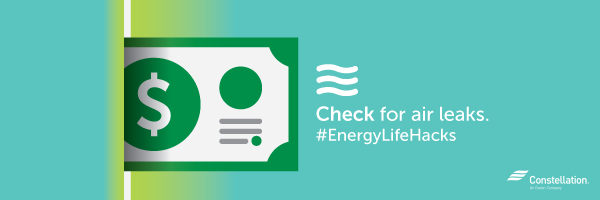
Eager to figure out how drafty your home really is? Try one of these DIY options.
Shine a flashlight at night over all potential gaps while a partner watches from outside. Large cracks will show up as rays of light.
Shut a door or window on a dollar bill. If you can pull the dollar bill out without it dragging, you’re losing energy.
Replacing your old heating systems (especially furnaces)
 If you own a furnace or boiler system from the 20th century, chances are good you’re losing money. Older furnace and boiler systems had efficiencies in the range of 56-70%. In contrast, modern conventional heating systems can achieve efficiencies as high as 98.5%, which means they convert nearly all the fuel you’re buying to useful heat for your home. Upgrading your furnace or boiler from one that operates at 56% to one in the 90% efficiency range can save someone living in an average cold climate house 1.5 tons of carbon dioxide emissions each year if you heat with gas, or 2.5 tons if you heat with oil, according to Energy.gov.
If you own a furnace or boiler system from the 20th century, chances are good you’re losing money. Older furnace and boiler systems had efficiencies in the range of 56-70%. In contrast, modern conventional heating systems can achieve efficiencies as high as 98.5%, which means they convert nearly all the fuel you’re buying to useful heat for your home. Upgrading your furnace or boiler from one that operates at 56% to one in the 90% efficiency range can save someone living in an average cold climate house 1.5 tons of carbon dioxide emissions each year if you heat with gas, or 2.5 tons if you heat with oil, according to Energy.gov.
“Your heating and cooling system is the largest energy user in your home,” Recor says. “A new high-efficiency heating and cooling system can pay for itself in energy savings within a relatively short period of time.”
Caveat: Before — or in conjunction with — replacing your furnace or boiler, be sure to implement other energy saving tips changes to further reduce your energy bill. Installing a new energy-efficient furnace but not dealing with a leaky duct or flue, for instance, will mean you’re not getting the full benefit of the furnace’s efficiency
Unplugging that second refrigerator or freezer
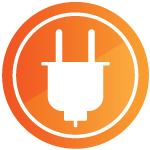 Refrigerators and freezers manufactured before 1993 can cost up to $150 in electricity to run each year. A second refrigerator or freezer, then, can be a real energy drain if it’s not fully utilized, i.e. actually full and used regularly. Nearly 15 percent of U.S. homes have a second refrigerator that is at least 20 years old, which means it is virtually certain to be an energy hog compared with today’s models. If you only need that second fridge/freezer occasionally, say around the holidays, then empty and unplug it the rest of the year. Ready to make the break? Recycle them for an instant energy savings, experts say.
Refrigerators and freezers manufactured before 1993 can cost up to $150 in electricity to run each year. A second refrigerator or freezer, then, can be a real energy drain if it’s not fully utilized, i.e. actually full and used regularly. Nearly 15 percent of U.S. homes have a second refrigerator that is at least 20 years old, which means it is virtually certain to be an energy hog compared with today’s models. If you only need that second fridge/freezer occasionally, say around the holidays, then empty and unplug it the rest of the year. Ready to make the break? Recycle them for an instant energy savings, experts say.
#EnergyLifeHacks

Not sure if you can make it with one fridge or freezer? Rearrange the shelves in your main appliances to maximize space. You might be surprised how much extra room you really have.
Turning off those gadgets when they’re not in use
 We are all savvier about realizing that our gadgets actually consume energy even when we think they’re “off.” What we may not realize, though, is how many of our products constantly draw power and how all that power adds up.
We are all savvier about realizing that our gadgets actually consume energy even when we think they’re “off.” What we may not realize, though, is how many of our products constantly draw power and how all that power adds up.
The average home has 40 products constantly drawing power, according to the Lawrence Berkeley National Laboratory. While some of them might seem insignificant alone — such as the amount of power drawn by a TV or by a coffeemaker programmed to brew in the morning — when you add them together, these sleeping devices can account for as much as 10 percent of household energy use, the lab reports.
The biggest phantom power consumers include any device with a remote control (think TV, DVD player or garage door opener); an external power supply (that clunky black box known as a “wall wart” on the plug for your router, printer or cable modem); a charger of any sort (cell phone, tablet, etc.); or any object with a continuous display (an alarm clock, oven, microwave, VCR or coffeemaker with a digital clock). Laptop computers and cable boxes (particularly cable boxes with integrated DVRs) are among the worst phantom power offenders, drawing an average of 9 watts and 44 watts in “off” mode, respectively, according to the lab.
Given these stats, unplugging devices you don’t use often is a worthwhile decision to lower your energy bill. Setting your computer to sleep mode or saving a video game and powering down rather than pausing it while you grab a drink can also help. These two changes alone can save more than $100 a year in energy costs.
#EnergyLifeHacks
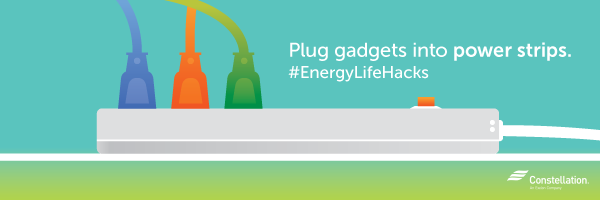
Want to make turning off multiple gadgets easier? Connect them to power strips so the on and off position is one toggle away. Using a power strip also eliminates the need to repeatedly unplug appliances from the wall, reducing the danger of frayed cords and wires. Another option? Use a light switch that turns power outlets on and off.




